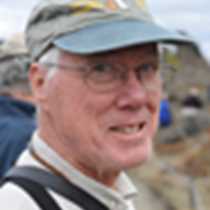New Island and Carcass Island, The Falklands
After our smooth and comfortable ride from Ushuaia, we have reached the Falkland Islands. This remote British outpost in the South Atlantic Ocean consists of two main islands, cleverly named East and West Falkland, and myriad smaller islands. We spent our day on two of the western islands. New Island has a rich history that includes sealing, whaling, and the raising of sheep, but now it is being turned into a Nature Preserve where seabirds can nest without disturbance. We walked a short distance across the island to a mixed colony of rockhopper penguins, Black-browed albatrosses, and blue-eyed shags. These are variations on a theme of black and white ... or so I used to think. Seen closely in the morning light, the shags actually have a striking reflective sheen of blue and green. It is spring in the Falklands, and the birds were well into their annual breeding activities. Shags were actively coming and going, bringing beaks full of grass to add to the nest and impress their mate. Their landings in the crowded colony were often less-than-graceful. There was a great deal of snake-dancing with their long necks and mutual preening as the shags establish their pair bonds. Their eggs have yet to come. Rockhopper penguins, with their yellow crests blowing in the wind, stood in pairs. They added an air of solemnity until they broke into their raucous calls. They are in the early incubation stage. Occasionally a skua swooped into a crowded part of the colony and emerged with an egg stolen from an inattentive penguin. The stately black-browed albatrosses sat quietly on their mud-pedestal nests, each bird incubating a single egg. We watched them soaring over the ocean as we made our passage from Ushuaia. Now, seeing them up close, we were truly impressed by their size.
For the afternoon, we moved to Carcass Island. Somehow, this island has escaped the scourge of introduced rats. It supports a rich array of ground-nesting birds that have been depleted on islands where rats are established. Whether we explored by long walk, short walk, photo walk, or private stroll, we ended at "the settlement" where the island's owners, Rod and Lillian Napier, invited us into their house for a traditional Falkland Islands tea. The table simply groaned with cookies, cakes, and scones topped with diddle-dee preserve and fresh cream from Carcass Island's resident cows. It gave us a fascinating window into life in "the camp", a vanishing way of life in the remote reaches of the Falkland Islands.




